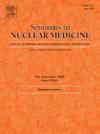SPECT 成像中的人工智能:机遇与挑战。
IF 5.9
2区 医学
Q1 RADIOLOGY, NUCLEAR MEDICINE & MEDICAL IMAGING
引用次数: 0
摘要
SPECT是一种在核医学中广泛应用的成像方式,它为心血管、神经和肿瘤疾病提供了基本的功能见解。然而,由于低空间分辨率和高噪声水平,SPECT成像的定量准确性有限,对精确诊断、疾病监测和治疗计划提出了重大挑战。人工智能(AI)的最新进展,特别是基于深度学习的技术,如卷积神经网络(cnn)、生成对抗网络(gan)和变压器,已经在SPECT图像重建、增强、衰减校正、分割、疾病分类和多模态融合方面取得了实质性的进步。这些人工智能方法能够更准确地提取功能和解剖信息,改进定量分析,并促进SPECT与其他成像方式的整合,以增强临床决策。这篇综述全面概述了人工智能在SPECT成像中的发展,强调了监督和无监督学习方法的进展,图像合成和跨模态学习的创新,以及自我监督和对比学习策略在提高模型鲁棒性方面的潜力。此外,我们还讨论了关键挑战,包括数据异质性、模型可解释性和计算复杂性,这些挑战继续限制人工智能方法的临床应用。标准化评估指标、大规模多模态数据集和临床验证的人工智能模型的需求仍然是确保人工智能方法可靠性和可推广性的关键因素。未来的研究方向包括探索知识驱动图像分析的基础模型和大型语言模型,以及为核成像应用量身定制更具适应性和个性化的AI框架。本文章由计算机程序翻译,如有差异,请以英文原文为准。
AI in SPECT Imaging: Opportunities and Challenges
SPECT is a widely used imaging modality in nuclear medicine which provides essential functional insights into cardiovascular, neurological, and oncological diseases. However, SPECT imaging suffers from limited quantitative accuracy due to low spatial resolution and high noise levels, posing significant challenges for precise diagnosis, disease monitoring, and treatment planning. Recent advances in artificial intelligence (AI), in particular deep learning-based techniques such as convolutional neural networks (CNNs), generative adversarial networks (GANs), and transformers, have led to substantial improvements in SPECT image reconstruction, enhancement, attenuation correction, segmentation, disease classification, and multimodal fusion. These AI approaches have enabled more accurate extraction of functional and anatomical information, improved quantitative analysis, and facilitated the integration of SPECT with other imaging modalities to enhance clinical decision-making. This review provides a comprehensive overview of AI-driven developments in SPECT imaging, highlighting progress in both supervised and unsupervised learning approaches, innovations in image synthesis and cross-modality learning, and the potential of self-supervised and contrastive learning strategies for improving model robustness. Additionally, we discuss key challenges, including data heterogeneity, model interpretability, and computational complexity, which continue to limit the clinical adoption of AI methods. The need for standardized evaluation metrics, large-scale multimodal datasets, and clinically validated AI models remains a crucial factor in ensuring the reliability and generalizability of AI approaches. Future research directions include the exploration of foundation models and large language models for knowledge-driven image analysis, as well as the development of more adaptive and personalized AI frameworks tailored for nuclear imaging applications.
求助全文
通过发布文献求助,成功后即可免费获取论文全文。
去求助
来源期刊

Seminars in nuclear medicine
医学-核医学
CiteScore
9.80
自引率
6.10%
发文量
86
审稿时长
14 days
期刊介绍:
Seminars in Nuclear Medicine is the leading review journal in nuclear medicine. Each issue brings you expert reviews and commentary on a single topic as selected by the Editors. The journal contains extensive coverage of the field of nuclear medicine, including PET, SPECT, and other molecular imaging studies, and related imaging studies. Full-color illustrations are used throughout to highlight important findings. Seminars is included in PubMed/Medline, Thomson/ISI, and other major scientific indexes.
 求助内容:
求助内容: 应助结果提醒方式:
应助结果提醒方式:


